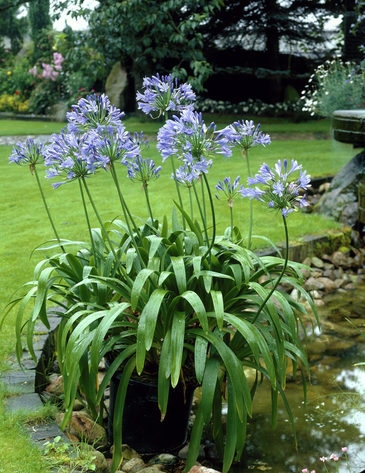Mastering the Art of Agapanthus Care: Necessary Actions for Healthy Growth and Dynamic Blossoms
In the realm of gardening, the farming of agapanthus stands as a rewarding venture for those that seek to support these classy flowering plants. With their striking blossoms and elegant vegetation, agapanthus has actually caught the attention of garden enthusiasts worldwide. Nonetheless, accomplishing ideal development and vivid blossoms requires a nuanced approach that incorporates different essential actions. From choosing the ideal variety to grasping trimming strategies, the journey towards growing prospering agapanthus plants is complex and holds the vital to opening the complete potential of these botanical gems.

Choosing the Right Agapanthus Variety

When selecting the right Agapanthus range for your garden, think about aspects such as climate suitability, bloom color, and growth routine. In addition, take into consideration the climate in your region to make sure the Agapanthus variety you choose can prosper in your specific problems. Recognizing the development practice of various Agapanthus ranges is important for correct positioning within your garden.
Ideal Growing Problems
Considering the optimum ecological requirements is vital for successful Agapanthus growing. Agapanthus thrives in well-draining soil with a somewhat acidic to neutral pH degree. When growing, choose a location that obtains complete sunlight to partial shade. In hotter climates, giving some afternoon color can prevent scorching of the fallen leaves. Agapanthus plants are sensitive to cold temperatures and need to be safeguarded from frost during cold weather.
To make sure healthy and balanced growth and vivid blooms, plant Agapanthus light bulbs at a depth of about 2-4 inches and room them 8-12 inches apart. Including raw material, such as garden compost, to the dirt can enhance water drainage and fertility, advertising robust root development. Mulching around the base of the plants assists retain dampness and subdues weed growth. Normal watering is important, especially during the expanding season, to keep the dirt continually wet but not waterlogged.
Watering and Feeding Tips
Preserving appropriate wetness levels and giving necessary nutrients are crucial elements in the care program for Agapanthus plants. It is crucial to strike a balance when it comes to sprinkling Agapanthus. If overwatered, these plants choose regularly damp dirt however are vulnerable to root rot. During the growing period, water deeply once a week, guaranteeing the soil is well-draining to avoid waterlogging. In hotter climates or during periods of drought, more regular watering might be essential to keep the soil uniformly moist. However, decrease watering in the wintertime to stop waterlogged problems.
Fertilizing Agapanthus is essential for advertising healthy development and prolific blooms. Apply a well balanced fertilizer, such as a 10-10-10 formula, in the very early spring as brand-new growth emerges. a fantastic read By complying with these watering and feeding tips, you can guarantee your Agapanthus plants thrive and produce dynamic, resilient blooms.
Trimming Techniques for Agapanthus
Pruning Agapanthus plants at the suitable times and with proper strategies is vital for maintaining their health and promoting optimal growth and blooming. The excellent time to prune Agapanthus is in late winter or very early spring before brand-new development arises.
For flowered stems, wait till the blossoms have withered and after that trim them back to the base. This not just cleans up the plant's appearance but additionally urges the advancement of brand-new flower buds. Deadheading spent blossoms can also reroute the plant's power right into generating more blossoms instead of establishing seeds. However, if you wish to collect seeds for proliferation, leave some blossoms to fully grown and dry on the plant.
Remember to use tidy, sharp tools to make precise cuts and minimize the danger of introducing conditions. Agapanthus. Routine pruning will certainly help keep your Agapanthus looking cool and healthy while making certain a bountiful screen of stunning blossoms
Taking Care Of Common Insects and Illness
After making sure correct pruning methods for Agapanthus, it is necessary to address common bugs and diseases that can influence the health and vigor of these plants. Agapanthus plants are typically sturdy but can still fall sufferer to particular problems. One typical parasite that affects Agapanthus is the Agapanthus gall midget. This little, orange fly lays its eggs in the foliage, resulting in altered development and blossom buds that fall short to open up. To fight this bug, trim and damage any damaged plant parts and consider using insecticidal soap.
Furthermore, Agapanthus plants can experience have a peek at this site from origin rot if they are grown in poorly draining pipes dirt. By being watchful and taking timely action versus diseases and bugs, you can assist your Agapanthus plants grow and generate dynamic blooms. Agapanthus.
:max_bytes(150000):strip_icc()/agapanthus-growing-guide-7368912_04-66a3f4cf245b4332b28954dd37c784f5.jpg)
Final Thought
To conclude, mastering the art of agapanthus treatment includes picking the appropriate variety, giving suitable growing conditions, correct watering and feeding, proper pruning techniques, and dealing with typical bugs and diseases. By adhering to these important actions, you can make certain healthy growth and lively blooms for your agapanthus plants. Bear in mind to regularly keep track of and maintain your plants to advertise their total well-being and long life.
To make certain healthy and balanced development and vivid blossoms, plant Agapanthus light bulbs at a depth of about 2-4 inches and space them 8-12 inches apart. By adhering to these watering and feeding tips, you can guarantee your Agapanthus plants visit this site right here thrive and create dynamic, long-lasting blooms.
One common bug that impacts Agapanthus is the Agapanthus gall midget. Furthermore, Agapanthus plants can experience from origin rot if they are planted in improperly draining soil. By complying with these crucial steps, you can guarantee healthy and balanced development and vivid blossoms for your agapanthus plants.